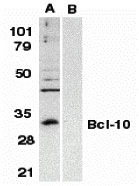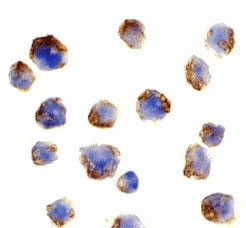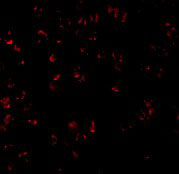Bcl-10 Antibody
- 产品详情
- 实验流程
- 背景知识
Application
| WB, IF, ICC, E |
|---|---|
| Primary Accession | O95999 |
| Other Accession | AF134395, 5070371 |
| Reactivity | Human, Mouse, Rat |
| Host | Rabbit |
| Clonality | Polyclonal |
| Isotype | IgG |
| Calculated MW | 26252 Da |
| Conjugate | Unconjugated |
| Application Notes | Bcl-10 antibody can be used for detection of BCL10 by Western blot at 0.5 µg/mL. dilution. An approximately 31 kDa band can be detected. Antibody can also be used for immunocytochemistry starting at 1 µg/mL. For immunofluorescence start at 10 µg/mL. |
| Gene ID | 8915 |
|---|---|
| Other Names | Bcl-10 Antibody: CLAP, mE10, CIPER, c-E10, CARMEN, CLAP, CARD-containing molecule enhancing NF-kappa-B, Bcl-10, B-cell CLL/lymphoma 10 |
| Target/Specificity | BCL10; |
| Reconstitution & Storage | Bcl-10 antibody can be stored at 4℃ for three months and -20℃, stable for up to one year. As with all antibodies care should be taken to avoid repeated freeze thaw cycles. Antibodies should not be exposed to prolonged high temperatures. |
| Precautions | Bcl-10 Antibody is for research use only and not for use in diagnostic or therapeutic procedures. |
| Name | BCL10 {ECO:0000303|PubMed:9989495, ECO:0000312|HGNC:HGNC:989} |
|---|---|
| Function | Plays a key role in both adaptive and innate immune signaling by bridging CARD domain-containing proteins to immune activation (PubMed:10187770, PubMed:10364242, PubMed:10400625, PubMed:24074955, PubMed:25365219). Acts by channeling adaptive and innate immune signaling downstream of CARD domain-containing proteins CARD9, CARD11 and CARD14 to activate NF-kappa-B and MAP kinase p38 (MAPK11, MAPK12, MAPK13 and/or MAPK14) pathways which stimulate expression of genes encoding pro-inflammatory cytokines and chemokines (PubMed:24074955). Recruited by activated CARD domain-containing proteins: homooligomerized CARD domain-containing proteins form a nucleating helical template that recruits BCL10 via CARD-CARD interaction, thereby promoting polymerization of BCL10, subsequent recruitment of MALT1 and formation of a CBM complex (PubMed:24074955). This leads to activation of NF-kappa-B and MAP kinase p38 (MAPK11, MAPK12, MAPK13 and/or MAPK14) pathways which stimulate expression of genes encoding pro-inflammatory cytokines and chemokines (PubMed:18287044, PubMed:24074955, PubMed:27777308). Activated by CARD9 downstream of C-type lectin receptors; CARD9-mediated signals are essential for antifungal immunity (PubMed:26488816). Activated by CARD11 downstream of T-cell receptor (TCR) and B-cell receptor (BCR) (PubMed:18264101, PubMed:18287044, PubMed:24074955, PubMed:27777308). Promotes apoptosis, pro-caspase-9 maturation and activation of NF-kappa-B via NIK and IKK (PubMed:10187815). |
| Cellular Location | Cytoplasm, perinuclear region. Membrane raft. Note=Appears to have a perinuclear, compact and filamentous pattern of expression. Also found in the nucleus of several types of tumor cells. Colocalized with DPP4 in membrane rafts. |
| Tissue Location | Ubiquitous.. |
For Research Use Only. Not For Use In Diagnostic Procedures.
Provided below are standard protocols that you may find useful for product applications.
BACKGROUND
Bcl-10 Antibody: Apoptosis is related to many diseases including cancer. Cell death signals are transduced by death domain (DD) and caspase recruitment domain (CARD) containing molecules and a caspase family of proteases. CARD containing cell death regulators include ARC, RAIDD, Apaf-1, caspase-9, and caspase-2. A novel CARD containing protein was recently identified by several groups and designated Bcl10, CIPER, mE10, CARMEN, CLAP. Bcl10 is a cellular homolog of the equine herpesvirus-2 E-10 gene. Overexpression of Bcl10 induces JNK, p38, and NF-κB activation. Bcl10 interacts with caspase-9 and enhances pro-caspase-9 processing and induces apoptosis through caspase-9 activation. Bcl10 exhibits a variety of mutations in MALT lymphomas and in B and T cell lineage lymphomas indicating that it may be commonly involved in the pathogenesis of human malignancy. Bcl10 is expressed in many human and murine tissues and cell lines.
REFERENCES
Willis TG, Jadayel DM, Du MQ, et al. Bcl10 is involved in t(1;14)(p22;q32) of MALT B cell lymphoma and mutated in multiple tumor types. Cell 1999;96(1):35-45
Koseki T, Inohara N, Chen S, et al. CIPER, a novel NF κB-activating protein containing a caspase recruitment domain with homology to Herpesvirus-2 protein E10. J Biol Chem 1999;274(15):9955-61
Yan M, Lee J, Schilbach S, Goddard A, Dixit V. mE10, a novel caspase recruitment domain-containing proapoptotic molecule. J Biol Chem 1999;274(15):10287-92
Thome M, Martinon F, Hofmann K, et al. Equine herpesvirus-2 E10 gene product, but not its cellular homologue, activates NF-κB transcription factor and c-Jun N-terminal kinase. J Biol Chem 1999;274(15):9962-8
终于等到您。ABCEPTA(百远生物)抗体产品。
点击下方“我要评价 ”按钮提交您的反馈信息,您的反馈和评价是我们最宝贵的财富之一,
我们将在1-3个工作日内处理您的反馈信息。
如有疑问,联系:0512-88856768 tech-china@abcepta.com.























 癌症的基本特征包括细胞增殖、血管生成、迁移、凋亡逃避机制和细胞永生等。找到癌症发生过程中这些通路的关键标记物和对应的抗体用于检测至关重要。
癌症的基本特征包括细胞增殖、血管生成、迁移、凋亡逃避机制和细胞永生等。找到癌症发生过程中这些通路的关键标记物和对应的抗体用于检测至关重要。 为您推荐一个泛素化位点预测神器——泛素化分析工具,可以为您的蛋白的泛素化位点作出预测和评分。
为您推荐一个泛素化位点预测神器——泛素化分析工具,可以为您的蛋白的泛素化位点作出预测和评分。 细胞自噬受体图形绘图工具为你的蛋白的细胞受体结合位点作出预测和评分,识别结合到自噬通路中的蛋白是非常重要的,便于让我们理解自噬在正常生理、病理过程中的作用,如发育、细胞分化、神经退化性疾病、压力条件下、感染和癌症。
细胞自噬受体图形绘图工具为你的蛋白的细胞受体结合位点作出预测和评分,识别结合到自噬通路中的蛋白是非常重要的,便于让我们理解自噬在正常生理、病理过程中的作用,如发育、细胞分化、神经退化性疾病、压力条件下、感染和癌症。








